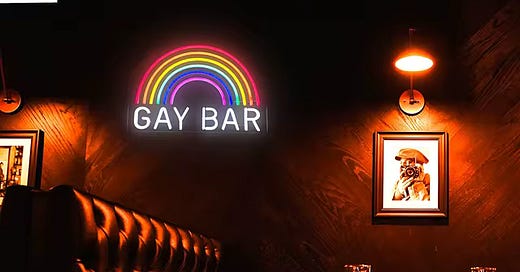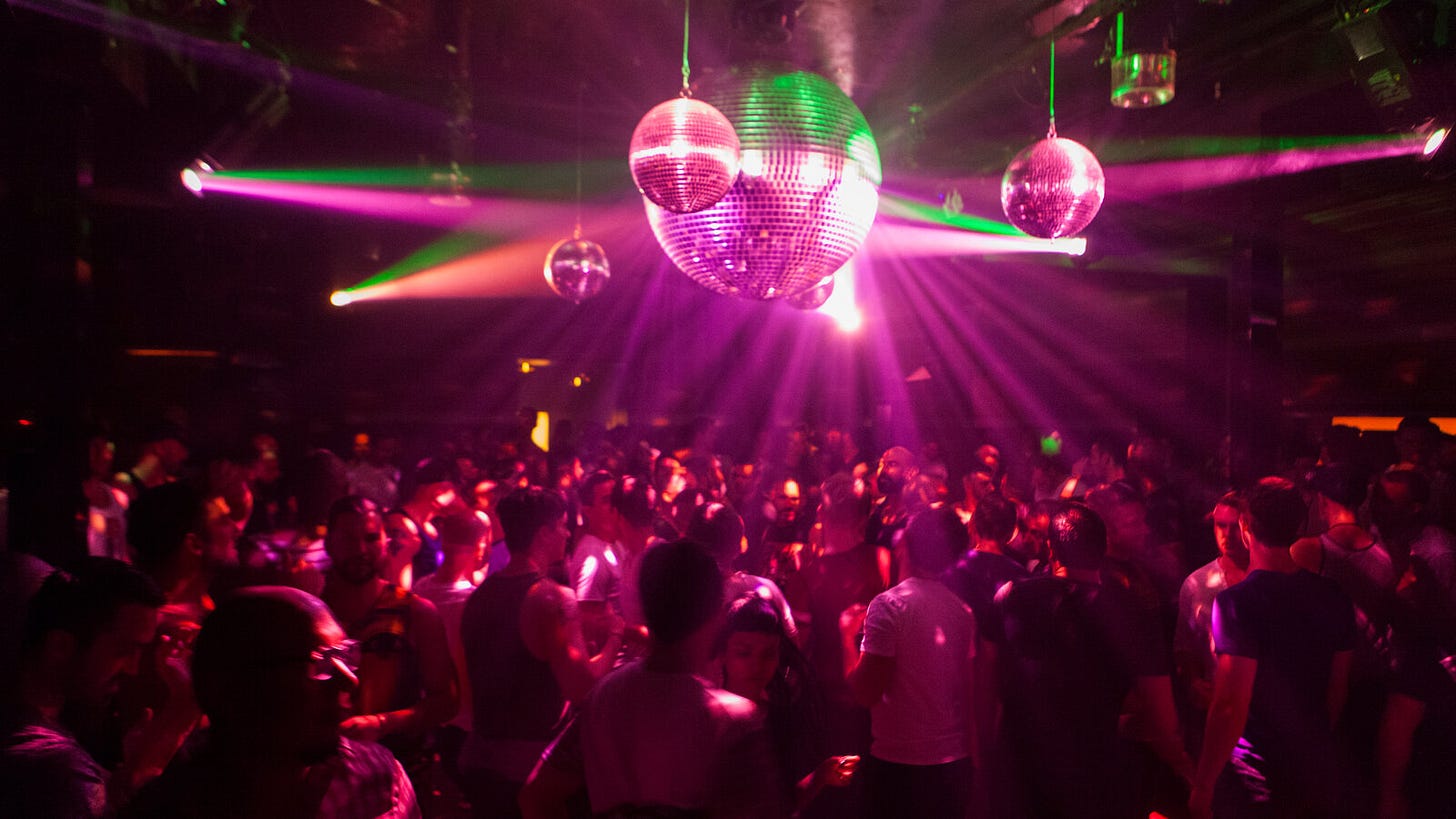Gay bars and other forms of queer nightlife are an important part of many LGBTQIA+ people’s lives. Queer nightlife is often a source of joy, pride, community, visibility, safety, care, and belonging.
But how do asexual people experience queer nightlife?
This is a question I examine in my latest publication in The Sociological Quarterly, which you can read here.
As I’ve argued before, asexuality is—or at least can be—queer. Yet, asexuality exists at the margins of not only the heteronormative world, but also the queer world. That marginality makes asexual perspectives especially valuable, but it also means that asexuality’s place in the broader queer community can feel shaky.
In other words, asexual people often experience what I call uncertain queer belonging.
I drew on 23 interviews with asexual individuals to examine how asexuality’s tenuous place in the broader queer community shapes asexual experiences of queer nightlife.
What I found is that uncertain queer belonging was core to understanding those experiences. I also found that some asexual avoid queer nightlife altogether. Perhaps most compellingly, I also found that some asexual respondents had suggestions that could make queer nightlife more inclusive… even for people who aren’t themselves asexual.
Uncertain Queer Belonging
Uncertainty defined many respondents’ perspectives on and relationships with queer nightlife.
Interviewees said that although they did not feel that asexual people were explicitly unwelcome in queer nightlife spaces, they also did not feel that asexual people were explicitly welcome. This created feelings of unease for many respondents. One interviewee, Feather, explained his discomfort like this:
“No, I wouldn’t say I’ve felt or seen anything that directly said ‘no aces allowed’ or anything like that. But I also wouldn’t say I’ve felt or seen anything that said we are allowed. It’s an ambiguous situation. It makes me feel like there’s a possibility I’m seen as an intruder in a space where maybe I don’t belong … . It’s awkward.”
Most of the people I interviewed had not had personal negative experiences with queer nightlife. But they were aware, often from online interactions, that some LGBTQIA+ people do not view asexuality as adequately queer. Without a queer space clarifying that asexual people are welcome, asexual people can feel uncertainty about whether or not they are truly welcome.
There’s another way of thinking about this: the absence of exclusion is not the same as the presence of inclusion.
Especially for marginalized groups, inclusion needs to be proactively created and offered for a space to feel welcoming.
Abstaining from the Party
Many of the people I interviewed said that they managed their feelings of uncertain queer belonging by simply keeping their asexuality private in queer nightlife spaces.
Others managed that uncertainty by avoiding queer nightlife altogether.
There were three main reasons for this: 1) the uncertainty outlined above, 2) previous bad or exclusionary experiences with other LGBTQIA+ people, and 3) feelings that queer nightlife spaces simply do not meet the needs/interests of asexual people.
Recall earlier my point that the absence of exclusion is not the same as the presence of inclusion. As a result, when queer nightlife spaces do not make inclusion explicit, interviewees could feel wary that their previous experiences of marginalization might be replicated. One interviewee, Caroline, explains:
“I was at Pride a few years back and I wore an ace pride shirt. I got talking with some people in a group near me and they asked what my shirt was. I explained it, and one of the guys, a gay guy, says something like “oh, so basically you’re straight.” It was so invalidating and erasing … I’m afraid—well maybe afraid isn’t exactly the right word—but I don’t want to deal with that … I don’t trust gay bars and other popular queer venues to be ace affirming unless they explicitly say so.”
Caroline’s final sentence is particularly important: “I don’t trust gay bars and other popular queer venues to be ace affirming unless they explicitly say so.”
Recall earlier my point that the absence of exclusion is not the same as the presence of inclusion. In other words, included/excluded is somewhat of a false binary: uncertain queer belonging falls in the fuzzy area between inclusion and exclusion.
Caroline helps us remember that the best way to address those feeling of uncertainty is to make explicit efforts to be inclusive, to dispel some of that fuzziness.
Expanding the Party
One question I asked interviewees was what made them feel included or welcomed in queer spaces. This led some respondents to reflect on ways queer spaces—and queer nightlife in particular—could be more welcoming and inclusive of asexual people.
Respondents raised a variety of suggestions and observations. One of the most common was simple: spaces should explicitly state that they are welcoming of asexual people, a suggestion that dovetails nicely with my argument that the absence of exclusion should not be mistaken for the presence of inclusion. Neil explains:
“It would help a lot if there was an explicit and visible statement that asexual people are allowed here. I’ve been to some bars and queer events that basically had community standards posted at the front door. Why not add something like ‘all members of the queer community are welcome here, including asexual, aromantic, intersex, agender’ and whatever other parts of the community are often forgotten.”
As I reflected on suggestions like Neil’s, I found myself suspecting that there’s often an assumption that queer spaces are de facto inclusive. After all, queer spaces are often filled with slogans like “love is love,” the progress pride flag, and other symbols and slogans that supposedly represent everyone under the LGBTQIA+ umbrella.
However, my interviews demonstrate how even signals that are meant to be broadly inclusive can feel marginalizing for those at a group’s edge. I really appreciate this quote from Caroline, because she reflects on how a supposedly all-inclusive symbol (a sign reading “fucking is freedom”) could feel marginalizing, but also how a more specific symbol (the ace pride flag) could have the opposite effect:
“I remember this one time going to a bar. And they have this big sign of like ‘fucking is freedom’ all in big letters as you go in. And I was like, oh, I don’t know if this place is for me. I don’t know this place is chill with ace people. But then I went to the bar and they had an ace flag there, and it honestly meant a lot to me … It was like, phew, cool, this place is a place I can belong.”
Symbols were not the only suggestion my interviewees raised.
Another suggestion raised by some respondents was labeling spaces as friendly to sexual contact or not. These respondents explained that this could help signal consent/non-consent and manage their feelings of awkwardness for being in queer spaces where some people might be seeking sexual partners.
I found these consent-oriented suggestions especially compelling for two reasons: 1) others have noted that non-consensual touch is a problem even for non-asexual people in queer nightlife spaces and 2) it serves as a reminder that queer people (and in this case asexual people) are uniquely positioned to imagine consent and how to have ethical sexual interactions.
This is just a brief summary of some of the findings I found particularly compelling. If you’re interested in reading the full article, you can find it here.
Coda
Spurred partially by the “epidemic” of gay bar closures, some argue that queer nightlife is in the midst of a renewal that increasingly centers the needs and interests of marginalized segments of LGBTQIA+ populations.
This period of potential renewal happens to coincide with growing awareness of asexuality as a legitimate (and queer) sexual identity. From my perspective, this creates valuable opportunities to build new bridges between asexuality and queer nightlife.
If nothing else, queer nightlife is defined by creativity, ingenuity and dynamism of queer people and communities. The confluence of queer nightlife’s renewal and surging awareness of asexuality may present new opportunities to imagine and create queer nightlife spaces that promote asexual belonging and foster expansive imaginations of queer community.
Canton Winer is an Assistant Professor of Sociology and Women, Gender, and Sexuality Studies at Northern Illinois University. His research focuses on the relationships between gender and sexuality, with specific focus on the experiences and perspectives of people on the asexuality spectrum. You can keep up with his research on Bluesky.
Want to support my research on asexuality? Consider becoming a contributing subscriber by clicking on the button above. I am committed to keeping my work free, without paywalls. Consider your paid membership a token of appreciation, an investment in research on asexuality, and a small but meaningful way to join a community that shares your interests.






This was so interesting! I'm an ace who doesn't like to drink/do drugs, has no interest in finding a romantic/sexual partner, and isn't crazy about loud dance music. So I've never been involved in nightlife because...what is there for me? If I'm not going to be dancing/drinking/flirting, then I'd just be sitting there like a bump on a log, harshing other people's vibes.
I don't begrudge anyone else nightlife, but I wish there were more spaces where queer people get together to do...other things. Just hang out, play games, talk, eat, etc. The only physical queer spaces I've found that aren't nightlife are explicitly political, and while I am a member of those and value them a lot, I'd like to be able to socialize too.